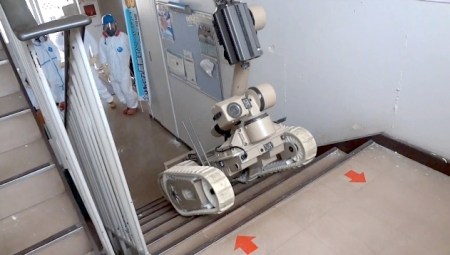After the terrible tragedy in Fukushima, the cleanup and damage assessment has begun. A robot operator, known only as [S.H.] has decided to write a blog about their efforts. As pictured above, they are using iRobot models, including the [510 Packbot], and the [710 Warrior].
Since cleanup efforts started, [S.H.] was posting on his or her blog daily. After word of this blog started getting out via various social media outlets, the blog was mysteriously taken down. The blog was at times critical of elements of the cleanup effort, but it’s unknown why the disappearance happened. Efforts to reach [S.H.] were unsuccessfull according to [IEEE].
Fortunately, before the takedown, [IEEE]’s [Erico Guizzo] decided to make a copy of the posts. These have been translated into English and portions are now available at the link listed above. Be sure to check out robot training video after the break.

















Ninja bots: never seen…
Good one!
It’s interesting they are using American robots, with all the money and research they spend on their own robots.
I imagine the reason is that they keep making those useless Asimo or other humanoid robots that don’t do anything.
Meanwhile iRobot has the right idea and makes robot suited for a single task, that don’t try to simulate some human behaviour..
This has been bought up a number of times, and basically, you are correct.
Japanese robot development is largely focused on creating humanoid robots and (eventually) androids; while US robotics tend to lean more towards the utilitarian.
Yeah, it’s not like they’re the leaders in automated automobile manufacturing or anything.
Wrong…
If you check the blog the operator of the robot said that he trained on an other robot.
It took 2-3 month after the disaster but a Japanese robot was send to the plant. Its name is Quince and it was able to achieve several missions (like going to the 3rd floor where the packbot could not climb stairs. It took time because it had to be modified to protect it from very high radiations and adapted to be able to be remotely controlled inside the plant (thick concrete walls). The packbot was ready and tested in Afganistan so it was the first robot to enter the plant.
Also the government (with nuclear companies) funded research on robots to enter nuclear plants few years ago. When the project was over the money stopped to come for the maintenance of the two robots built. Nobody thought they would be of any use anyway, as they strongly believed this disaster would never occured. For few years the “useless” two nuclear plant robots have been displayed in a museum in Sendai and in the lobby of Tohoku university. Sendai, the capital of the region where effects of the quake and the tsunami were the worse.
Wow, that’s really ironic/sad about the robots being in the museum there…
Hmmm… This is reminding me of Portal. All the scientist are driven out by danger, so the robots go in to shut it down.
If you want to read what the MSM doesn’t report about Fukushima, check out enenews.com
Also check the ex-skf blog and fukushima diary.
It’s not exactly over yet…
If you look at where the funding comes from you’ll understand the design of the robots.
Japans’ robots get their funding from car manufacturers and electronics firms(Sony) whereas the bulk of the US robot budget comes from military and gov’t contracts. Japan is building a comodity, the US is building weapons platforms
This has all happened before and will happen again…
“terrible tragedy in Fukushima”? a bit melodramatic don’t you think? considering there have, as yet, been no reported deaths associated with the event. That is, if you are referring to the damage done to the Fukushima nuclear reactor. If you are referring to the tidal wave itself, that, indeed, was a terrible tragedy.
Actually, workers have been dieing already. Thousands of children have lumps in their thyroids, infant mortality has more than doubled, dead animals are piling up around fukushima, hospitals are flooded with people with radiation poisoning. Even the west coast of North America had a 35% increase in infant mortality. But by all means, keep drinking you MSM koolaid, everything is fine.
Yes, definitely not terrible. The radiation problem, the possible leached uranium from the sea water injection from the emergency cool down, the various types of cancers associated with radiation are nothing. Just as long as there is not real immediate loss of life, that’s all that matters.
Wow, short-sightedness like this has never been a problem.
Gary, are you a politician… or a banker by any chance? Work for the Federal Reserve Bank?
Cancers are also linked to high sodium intake, red meat, lack of (dietary) fibers, lack of exercise, underconsumption of capsaicin, overconsumption of capsaicin, plastic softeners, fried food…
The problems are real however the risks excepting the immediate surroundings of the reactor complex is minimal.
Compare this to the Chernobyl where the spread of long lived radioactive contaminants were definitely non-local and worsened by the weather.
You are an idiot IMO, but how about the tragedy of thousands having to leave their home and in fact entire area not to ever return in their lifetime, leaving everything behind.
Plus all the animals that were left to fend for themselves, I’d call it a tragedy even if radiation actually did not eventually kill many (as it will.)
But would you call it a ‘terrible’ tragedy?
Wall-E!
Got some bad news. Um… Operation Cleanup has, well uh, failed. Wouldn’t you know, rising toxicity levels have made life unsustainable on Earth.
Could “Robot” be another of those genders? Proper pronoun is “it”.
At least a good reason for a non-binary gender